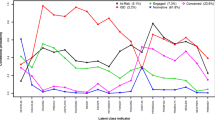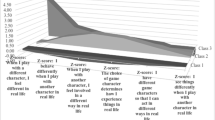Abstract
Objective Excessive video gaming may represent a behavioural addiction among adolescents. The objective of this study was to identify and describe the taxonomy of problem gamers based on responses to the Problem Video Game Playing (PVP) scale. Methods Data based on 3338 Ontario high schoolers sampled from 103 schools (aged 11–20; male = 51 %) who completed self-administered questionnaires. Following latent class extraction, a regression assessed the association between the derived classes and the covariates sex and socioeconomic status. We also assessed self-rated physical and mental health as auxiliary variables in the model to evaluate the predictive validity of the extracted classes. Results A 4-class model provided the best statistical fit to the nine PVP symptoms. The Severe PVP, High PVP, Low PVP and Normative classes comprised 1.9 %, 12.2 %, 36.0 % and 50.0 % of the sample, respectively. The Severe PVP class was characterized by having the highest probabilities of endorsing the PVP items. The High PVP class was differentiated from the Severe PVP class by having lower probabilities of endorsing the disregard for consequences and the lies and deception items and moderate probabilities of endorsing withdrawal and escape items. Significantly poorer physical and mental health outcomes differentiated the Severe PVP class from the remaining classes. Conclusions Adolescent problem video gamers are not homogeneous. They experience differing patterns of symptoms requiring attention of prevention programmers and clinicians.



Similar content being viewed by others
References
American Psychiatric Association. (2013). Diagnostic and Statistical Manual of Mental Disorders (5th ed.). Arlington, VA: American Psychiatric Publishing.
Asparouhov, T., & Muthén, B. (2008). Multilevel mixture models. In G. R. Hancock & K. M. Samuelsen (Eds.), Advances in latent variable mixture models (pp. 27–51). Charlotte, NC: Information Age.
Biddle, S. J. H., Gorely, T., Marshall, S. J., Murdey, I., & Cameron, N. (2004). Physical Activity and Sedentary Behaviours in Youth: Issues and Controversies. Journal of the Royal Society for the Promotion of Health, 124, 29–33. doi:10.1177/146642400312400110.
Bioulac, S., Arfi, L., & Bouvard, M. P. (2008). Attention Deficit/Hyperactivity Disorder and Video Games: a Comparative Study of Hyperactive and Control Children. European Psychiatry, 23, 134–141. doi:10.1016/j.eurpsy.2007.11.002.
Blaszczynski, A., & Nower, L. (2002). A Pathways Model of Problem and Pathological Gambling. Addiction, 97, 487–499. doi:10.1046/j.1360–0443.2002.00015.x.
Canadian Society of Exercise Physiology. (2011). Canadian Physical Activity Guidelines. Retrieved September 27, 2013, from http://www.csep.ca/CMFiles/Guidelines/CSEP-InfoSheets-youth-ENG.pdf.
Carson, V., & Janssen, I. (2012). Neighborhood Disorder and Screen Time Among 10–16 Year old Canadian Youth: a Cross-Sectional Study. International Journal of Behavioural Nutrition and Physical Activity, 9, 66. doi:10.1186/1479–5868–9–66.
Centre for Addiction and Mental Health. (2012). Ontario Student Drug Use and Health Survey. Retrieved September 27, 2013, from http://www.camh.ca/research/osduhs.aspx.
Cole, T. J., Bellizzi, M. C., Flegal, K. M., & Dietz, W. H. (2000). Establishing a Standard Definition for Child Overweight and Obesity Worldwide: International Survey. British Medical Journal, 320, 1240–1243.
Croon, M. (2002). Ordering the Classes. In J. A. Hagenaars & A. L. McCutcheon (Eds.), Applied Latent Class Analysis (pp. 137–162). New York: Cambridge University Press.
D’Arcy, C. (1998). Social distribution of health among Canadians. In D. Coburn, C. D’Arcy, & G. M. Torrance (Eds.), Health and Canadian Society: Sociological Perspectives (3rd ed., pp. 73–101). Toronto: University of Toronto Press.
Demetrovics, Z., Urban, R., Nagygyorgy, K., Farkas, J., Griffiths, M. D., Papay, O., Kokonyei, G., Felvinczi, K., & Olah, A. (2012). The Development of the Problematic Online Gaming Questionnaire (POGQ). PloS One, 7(5), e36417.
Desai, R. A., Krishnan-Sarin, S., Cavallo, D., & Potenza, M. N. (2010). Video-Gaming Among High School Students: Health Correlates, Gender Differences, and Problematic Gaming. Pediatrics, 126, e1414–1424. doi:10.1542/peds.2009–2706.
Ferguson, C. J., Coulson, M., & Barnett, J. (2011). A Meta-Analysis of Pathological Gaming Prevalence and Comorbidity with Mental Health, Academic and Social Problems. Journal of Psychiatric Research, 45, 1573–1578. doi:10.1016/j.jpsychires.2011.09.005.
Gentile, D. A. (2009). Pathological Video-Game Use Among Youth Ages 8 to 18: a National Study. Psychological Science, 20, 594–602. doi:10.1111/j.1467–9280.2009.02340.x.
Gentile, D. A., Choo, H., Liau, A., Sim, T., Li, D., Fung, D., & Khoo, A. (2011). Pathological Video Game use Among Youths: a Two-Year Longitudinal Study. Pediatrics, 127, e319–e20. doi:10.1542/peds.2010–1353.
Goldberg, D. P., & William, P. (1998). A user’s guide to the General Health Questionnaire. Windsor, UK: NFER-N.
Goldberg, D. P., Gater, R., Sartorius, N., Ustun, T. B., Piccinelli, M., Gureje, O., & Rutter, C. (1997). The Validity of Two Versions of the GHQ in the WHO Study of Mental Illness in General Health Care. Psycholical Medicine, 27, 191–197.
Goodman, E., Adler, N. E., Kawachi, I., Frazier, A. L., Huang, B., & Colditz, G. A. (2001). Adolescents’ Perceptions of Social Status: Development and Evaluation of a New Indicator. Pediatrics, 108, e31. doi:10.1542/peds.108.2.e31.
Griffiths, M. D., Parke, J., & Derevensky, J. L. (2011). Remote gambling in adolescence. In J.L. Derevensky, D.T. Shek & J. Merrick J (Eds.), Youth Gambling: The Hidden Addiction (pp. 125–143). Berlin/Boston: De Gruyter.
Griffiths, M. D., King, D. L., & Demetrovics, Z. (2014). DSM-5 Internet Gaming Disorder Needs a Unified Approach to Assessment. Neuropsychiatry, 4, 1–4.
Groves, R., & Peytcheva, E. (2008). The Impact of Nonresponse on Nonresponse Bias: a Meta-Analysis. Public Opinion Quarterly, 72, 167–189.
Gupta, R., & Derevensky, J. (2011). Defining and assessing binge gambling. In J.L. Derevensky, D.T. Shek & J. Merrick J (Eds.), Youth Gambling: The Hidden Addiction (pp. 79–97). Berlin/Boston: De Gruyter.
Hagenaars, J. A., & McCutcheon, A. L. (2002). Applied Latent Class Analysis. New York: Cambridge University Press.
King, D. L., & Delfabbro, P. H. (2013). Issues for DSM-5: Video-Gaming Disorder? Australia and New Zealand Journal of Psychiatry, 47, 20–22. doi:10.1177/0004867412464065.
King, D. L., Delfabbro, P. H., Zwaans, T., & Kaptsis, D. (2013). Clinical Departures and Axis 1 Comorbidity of Australian Adolescent Pathological Internet and Video Game Users. Australia and New Zealand Journal of Psychiatry, 47, 1058–1067. doi:10.1177/0004867413491159.
Korn, E., & Graubard, B. I. (1999). The Analysis of Health Surveys. New York: John Wiley.
Kuss, J. D., & Griffiths, M. D. (2011). Internet Gaming Addiction: A Systematic Review of Empirical Research. International Journal of Multimedia & its Applications, 10, 278–296. doi:10.1007/s11469-011-9318-5.
McDowell, I. (2006). Measuring health: A guide to rating scales and questionnaires (3rd ed.). New York: Oxford University Press.
Mentzoni, R. A., Brunborg, G. S., Molde, H., Myrseth, H., Skouverøe, K. J., Hetland, J., & Pallesen, S. (2011). Problematic Video Game use: Estimated Prevalence and Associations with Mental and Physical Health. Cyberpsychology, Behavior and Social Networking, 14, 591–596. doi:10.1089/cyber.2010.0260.
Moffitt, T. E. (2006). Life-course-persistent versus adolescence-limited antisocial behavior. In D. Cicchetti & D. J. Cohen (Eds.), Developmental psychopathology (Risk, disorder, and adaptation, 2nd edition, Vol. 3, pp. 570–598). Hoboken, NJ: John Wiley & Sons.
Muthén, B. (2002). Should Substance use Disorder be Considered as Categorical or Dimensional? Addiction, 101, 6–16. doi:10.1111/j.1360–0443.2006.01583.x.
Muthén, L. K., & Muthén, B. O. (1998–2011). Mplus User’s Guide Version 11.2. Los Angeles, CA: Muthén and Muthén.
Nower, L., & Blaszczynski, A. (2004). The Pathways Model as Harm Minimization for Youth Gamblers in Educational Settings. Child and Adolescent Social Work Journal, 21, 25–45. doi:10.1023/B:CASW.0000012347.61618.f7.
Nylund, K. L., Asparouhov, T., & Muthén, B. (2007). Deciding on the Number of Classes in Latent Class Analysis and Growth Mixture Modeling: a Monte Carlo Simulation Study. Structural Equation Modeling, 14, 535–569.
Paglia-Boak, A., Adlaf, E. M., & Mann, R. E. (2011). Drug use among Ontario students, 1977–2011: Detailed OSDUHS findings (CAMH Research Series Document 33). Toronto, ON: Centre for Addiction and Mental Health.
Pápay, O., Urban, R., Griffiths, M. D., Nagygyorgy, K., Farkas, J., Kokonyei, G., Felvinczi, K., Olah, A., Elekes, Z., & Demetrovics, Z. (2013). Psychometric Properties of the Problematic Online Gaming Questionnaire Short-Form (POGQ-SF) and Prevalence of Problematic Online Gaming in a National Sample of Adolescents. Cyberpsychology, Behavior and Social Networking, 16, 340–348.
Patterson, B. H., Dayton, M., & Graubard, B. I. (2002). Latent Class Analysis of a Complex Sample Survey Data: Application to Dietary Data. Journal of the American Statistical Association, 97, 721–741. doi:10.1198/016214502388618465.
Pearson, N., & Biddle, S. J. (2011). Sedentary Behavior and Dietary Intake in Children, Adolescents, and Adults: a Systematic Review. American Journal of Preventive Medicine, 41, 178–188. doi:10.1016/j.amepre.2011.05.002.
Ramaswany, V., De Sarbo, W., Reibstein, D., & Robinson, W. (1993). An Empirical Pooling Approach for Estimating Marketing Mix Elasticities with PIMS Data. Marketing Science, 12, 103–124.
Rehbein, F., Psych, G., Kleimann, M., Mediasci, G., & MoBle, T. (2010). Prevalence and Risk Factors of Video Game Dependency in Adolescence: Results of a German Nationwide Survey. Cyberpsychology, Behavior and Social Networking, 13, 269–277. doi:10.1089/cyber.2009.0227.
Tejeiro Salguero, R. A., & Morán, R. M. B. (2002). Measuring Problem Video Game Playing in Adolescents. Addiction, 97, 1601–1606. doi:10.1046/j.1360–0443.2002.00218.x.
Tejeiro Salguero, R. A., Gomez-Vallecillo, J. L., Pelegrina, M., Wallace, A., & Emberley, E. (2012). Risk Factors Associated with the Abuse of Video Games in Adolescents. Psychology, 3, 310–314. doi:10.4236/psych.2012.34044.
Tremblay, M. S., LeBlanc, A. G., Kho, M. E., Saunders, T. J., Larouche, R., Colley, R. C., Goldfield, G., & Connor Gorber, S. (2011a). Systematic Review of Sedentary Behaviour and Health Indicators in School-Aged Children and Youth. International Journal of Behavioural Nutrition and Physical Activity, 8, 98. doi:10.1186/1479–5868–8–98.
Tremblay, M. S., Leblanc, A. G., Janssen, I., Kho, M. E., Hicks, A., Murumets, K., Colley, R. C., & Duggan, M. (2011b). Canadian Sedentary Behaviour Guidelines for Children and Youth. Applied Physiology, Nutrition, and Metabolism, 36, 59–71. doi:10.1139/H11–012.
Turner, N. E., Jain, U., Spence, W., & Zangeneh, M. (2008). Pathways to Pathological Gambling: Component Analysis of Variables Related to Pathological Gambling. International Gambling Studies, 8, 281–298.
Turner, N. E., Ialomiteanu, A., Paglia-Boak, A., & Adlaf, E. M. (2011). A Typological Study of Gambling and Substance Use Among Adolescent Students. Journal of Gambling Issues, 25, 88–107. doi:10.4309/jgi.2011.25.7.
Turner, N. E., Paglia-Boak, A., Ballon, B., Cheung, J. T. W., Adlaf, E. M., Henderson, J., Chan, V., Rehm, J., Hamilton, H., & Mann, R. E. (2012). Prevalence of Problematic Video Gaming Among Ontario Adolescents. International Journal of Mental Health and Addiction, 10, 877–889. doi:10.1007/s11469–11012–19382–11465.
Van Rooij, A. J., Schoenmakers, T. M., Vermulst, A. A., van den Eijnden, R. J. J. M., & van de Mheen, D. (2010). Online Video Game Addiction: Identification of Addicted Adolescent Gamers. Addiction, 106, 205–212. doi:10.1111/j.1360–0443.2010.03104.x.
Vermunt, J. K. (2008). Latent Class and Finite Mixture Models for Multilevel Data Sets. Statistical Methods in Medical Research, 17, 33–51.
Vermunt, J. K., & Magidson, J. (2002). Latent Class Cluster Analysis. In J. A. Hagenaars & A. L. McCutcheon (Eds.), Applied Latent Class Analysis (pp. 89–106). New York: Cambridge University Press.
World Health Organization. (2011). BMI Classification. Retrieved September 27, 2013, from http://apps.who.int/bmi/index.jsp?introPage=intro_3.html.
Acknowledgments
Preparation of this work was funded in part by ongoing support from the Ontario Ministry of Health and Long Term Care. We would like to thank all the schools and students that participated in the study, and the Institute for Social Research at York University for assistance with the survey design and data collection.
Conflict of Interest
The authors do not have a financial relationship with the organization that sponsored the research. Guy Faulkner, Hyacinth Irving, Edward Adlaf and Nigel Turner declare that they have no conflict of interest.
Author information
Authors and Affiliations
Corresponding author
Rights and permissions
About this article
Cite this article
Faulkner, G., Irving, H., Adlaf, E.M. et al. Subtypes of Adolescent Video Gamers: a Latent Class Analysis. Int J Ment Health Addiction 13, 1–18 (2015). https://doi.org/10.1007/s11469-014-9501-6
Published:
Issue Date:
DOI: https://doi.org/10.1007/s11469-014-9501-6




